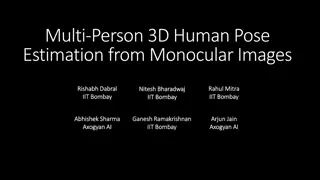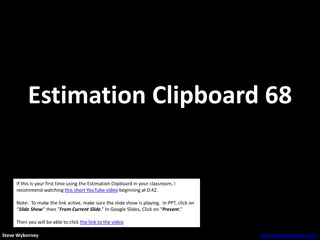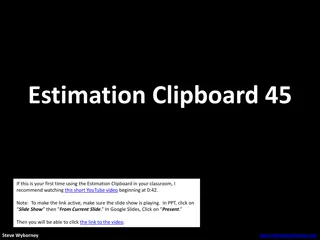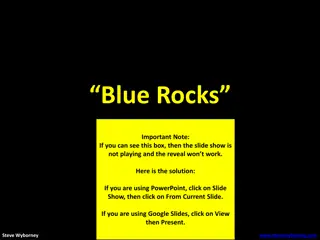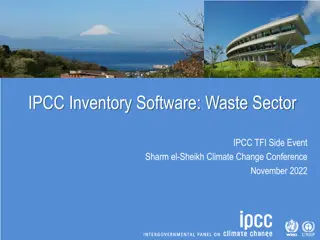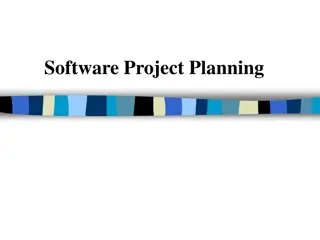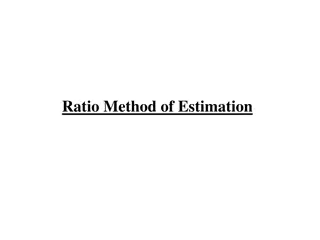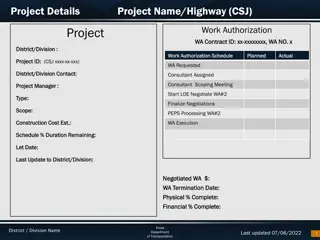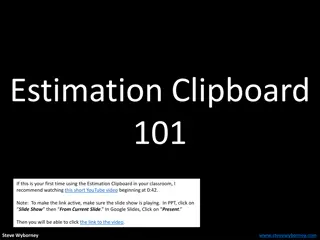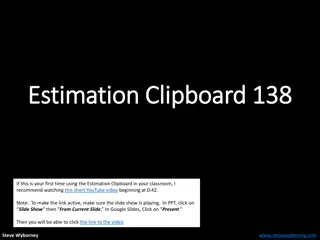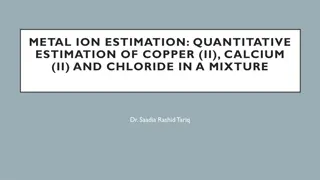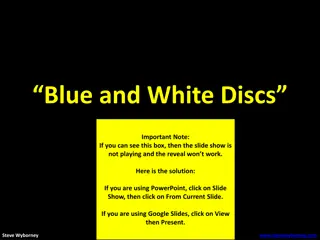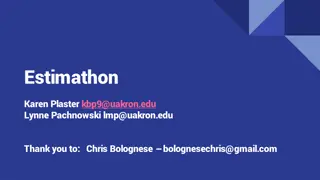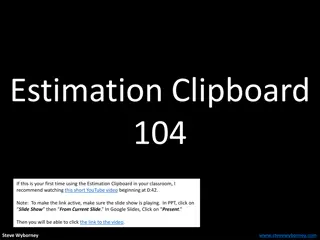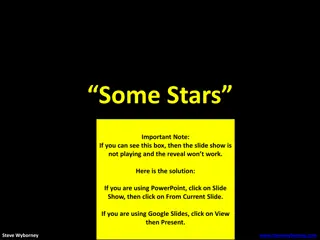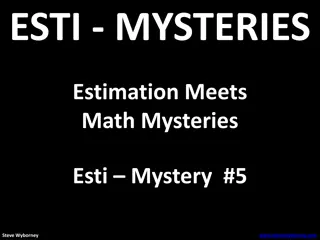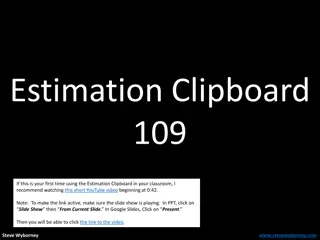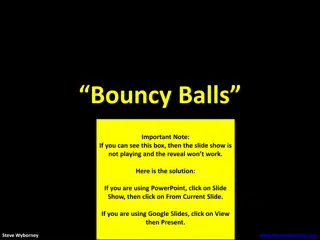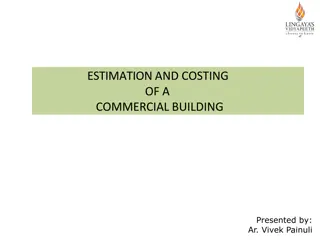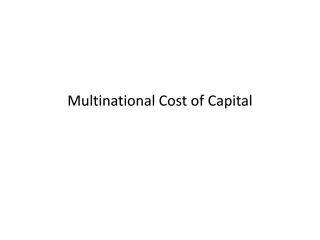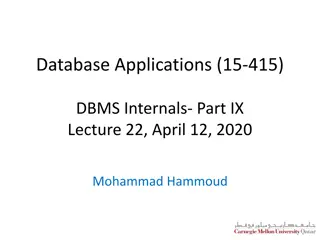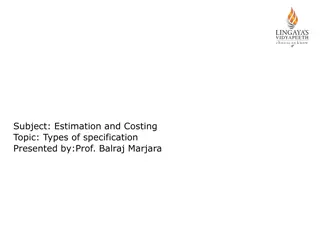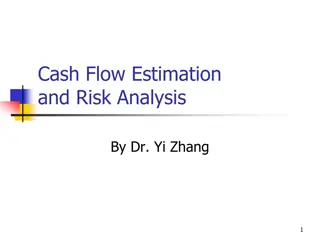Project Cost Estimation: Methods and Factors
Project cost estimation involves valuing all monetary aspects necessary for planning, implementing, and monitoring a project. This includes various entrants such as preliminary investigation costs, design fees, construction expenses, and more. The purpose of cost estimation is to determine work volume, actual cost per unit, and bid accurately. Factors affecting cost estimation include project type, construction scheduling, material quality, and site location. Different types of costing methods, such as preliminary costing, are used to assess project feasibility before detailed designs begin.
Download Presentation

Please find below an Image/Link to download the presentation.
The content on the website is provided AS IS for your information and personal use only. It may not be sold, licensed, or shared on other websites without obtaining consent from the author. Download presentation by click this link. If you encounter any issues during the download, it is possible that the publisher has removed the file from their server.
E N D
Presentation Transcript
Specification & Quantity Survey By Eshetu TS.
Chapter 4 Chapter 4 Cost Estimation Cost Estimation 4.1 Project Cost Estimation Project Cost estimation is the process of valuing on monetary expression, including the cost of all possible entrants necessary for the planning, implementing and monitoring stages of the proposed project under consideration. The possible entrants are: - Preliminary investigation (project appraisal costs) - design and supervision (consultancy cost ) - construction works (contractor s cost ) - land owning cost, and - monitoring costs
4.2 Purpose of Cost Estimation The main purpose of costing or estimating are to: know the volume of work in reference to the fund available determine actual cost per unit of item Identifying engineering estimate of the work for bidding purpose work out economical use of materials , labor and equipments In cases of variations to determine the extra cost to be incurred when changes in cost due to legislation happens, to work out the escalation in cost
The following information is required to define cost per unit of work 1. Correct information of the market price of the materials at the time of need to be used as a basic price. 2. Correct information of the rates of various categories of skilled and unskilled laborers as wage rates to be used for daily work rate. 3. Output of laborers per day for various types of items (productivity) 4. Correct information of the rates of various categories of equipments and tools as rental rates to be used for major items of rates. 5. Up-to-date knowledge of the construction methods.
4.3 Factors affecting cost estimation 1) Type and documentation of the project 2) Construction scheduling 3) Bidding environment 4) Quality and availability of material and labor 5) Construction facilities /tools and method of construction 6) Location of the site: Transportation charges 7) Proper management 8) Land charges (lease) 9) Nature of subsurface condition
Types of Costing or Estimation I. Preliminary /approximate costing Rates are determined either from practical knowledge or from records of similar previous works. This type of cost estimation is required to know the financial position of the client before costly detailed designs are carried out. Examples of approximate cost estimations are as follows:
A. Cost per functional unit Hospital =cost per bed, Dormitory = cost per student, Cinema or theatre = cost per seat, residential buildings = cost per area, road works = cost per kilometer length, culverts or bridges = cost per meter span, water supply or sewerage projects = cost per head of population.
B. Plinth area method cost per m2 This estimate is prepared on the basis of plinth area of the building. The rate per meter square is deduced from the cost of similar building projects in the locality. The plinth area shall be calculated based on the roof area, by taking external dimensions of the building at the plinth level.
C. Cubical Content method cost per m3 The estimate is based on cubical contents of various buildings, i.e. plinth area of the building x height x cubic content rate. Height should be taken from the top of flat roof (or halfway of the sloped roof) to the top of concrete in foundation.
Purpose of approximate Estimate i) To investigate feasibility ii) To save time and money iii) To investigate benefit and comparison of cost with utility. iv) Adjustment of Planning. v) To obtain administrative approval:
II. Detailed cost estimate( based on item rate) This is the most reliable and accurate type of estimate. The quantities of items are carefully prepared from the drawings and the total cost worked out from up to date market rates. A detail cost estimate thus requires quantity surveying and analysis of the different rates for the quantities prepared.
Composition of Project Price The total price of a construction project is the sum of direct costs, contingency costs, and margin. Direct costs: are the labor, material, and equipment costs of project construction. Contingency costs: are those that should be added to the costs initially calculated to take into account events, that are likely to occur during the course of the project and affect overall project cost. Margin (sometimes called markup): has three components: indirect (distributable) costs; company- wide (general & administrative) costs; and profit.
Indirect costs: are project-specific costs that are not associated with a specific physical item. They include the cost of project management, payroll preparation. Company-wide costs include: (1) Costs that are incurred during the course of a project but are not project related. (2) Costs that are incurred before or after a project. Profit:is the amount of money that remains from the funds collected from the client after all costs have been paid.
Disposition of the Cost Calculation i) Direct itemized costs: A. Material costs Construction/Building material Operating supplies Loading, unloading and transportation costs Wastages
required information: Quantity of material required to produce a unit amount of itemized work Basic price (Prime cost) at the source of material Transport, loading and unloading to the site Waste/loss (e.g. Breaking, rupture, defective material, wastage etc).
B. Labor costs: include Standard wages Extra and supplementary pay for o Production bonus oLong continuity of Service (permanent laborer) oOver time pay oProperty creating performance oLess favorable condition
Social Service payments Holiday pay if any Health insurance Unemployment insurance Payment during sickness
Required information for the calculation of labor cost Number and type of skilled and unskilled manpower for a particular type of work, (Crew) Performance of crew per hour for a unit amount of work Indexed hourly cost of the workman ship. Utilization factor of the workmanship. Share of a particular personal per hour for the specified work.
C. Equipment costs: -All costs for commissioning /holding and operation of the equipment. ownership of plant hire of plant - Standing Costs: includes capital sum based on purchase price and operating cost, maintenance, tax and insurance. - Operating Costs: operators cost, fuel, consumable stores. Required information: Type of equipment for a particular item of work. Performance of equipment per hour for a unit amount of work (production rate)
D. Costs for sub-contractor:- If the work is to be Sublette to a nominated subcontractor, the cost shall be determined and separately established as a sub contractor fee. Ex. Marble cladding -Supply and fix items (aluminum frames) -Furniture etc.
ii) Indirect Costs A. Site over head costs Time-independent costs Costs for site plant/ site installation Cost for site facilities Engineering and controlling Operation risks Special costs
Time-dependent costs Commissioning /holding costs Operating costs Costs for contractor s agent B. General overhead costs C. Risks and profit
Direct cost + Site overhead Cost = Production cost Production cost +General overhead cost = Self-costs Self- costs + Risk& profit = Bid sum Bid sum + Vat = Bid sum inclusive vat.
Example a) Calculation of material cost 1) Calculation of the material costs of 1m3 concrete C-25 grade given. -1Qtl of cement -355 Birr -1truck of Sand (6 m3 ) from source to Site 1500 Birr -1 truck of gravel (6m3) from source to site 1200 Birr -1m3 water 10 Birr -Transportation cost 5 Birr/Qtl/Km -Wastage 5%
Type of material Cement Sand Gravel Water Unit Qty Unit rate Cost/unit Qtl M3 M3 M3 7 0.5 0.75 0.3 355 250 200 10 2485 125 150 3 2763 Sum Loss 5% 138.15 Total 2901.15 Birr/m3
b) Calculation of Labor cost Calculation of labor cost for a m3 of concrete; production rate 1.25 m3 /hr Labour No UF Index hourly cost Hourly cost (Birr) Forman 1 1/2 10 5 mason 1 1 7.5 7.5 engineer/ma nager 1 1/10 56.8 5.68 Assistance mason 2 1 5.5 11 D. Laborer 18 1 4 72 Total 101.18 Labour cost = 101.18/1.25 = 80.944/m3
C) Calculation of Equipment cost Calculation of equipment cost for m3 of concrete Mixer - Original cost = 500,000 Birr Useful life = 3yrs Monthly repair cost with supplies: - 700 Birr Vibrator- Original cost = 350,000 Birr Useful life = 7yrs Repair cost monthly = 450 Birr Assume 8 working hours per day and 22 days per month
Two methods of calculation are followed. I) With charges accounted for depreciation, interest return and monthly repair costs II) With monthly rental charges. Hourly equipment cost i) Mixer Depreciation (d) =500,000 Birr = 78.9 Birr/hr 3x12(22x8) hr Hourly repair cost = 700/8x22 = 3.98 Birr/hr Hourly Mixer cost = 78.9 + 3.98 = 82.88 Birr/hr
ii) Vibrator Depreciation (d) = 350,000/(7x12x8x22) =23.6Birr/hr Repair cost = 450/(8x22) = 2.5 Birr /hr Hourly vibrator cost = 23.6+ 2.5 = 26.1 Birr/hr Total hourly cost (Birr) = 108.98 Birr/hr Equipment cost for (1m3 concrete) 108.98/1.25 = 87.18 Birr/ m3
Equipment cost using monthly rental changes Mixer= 500,000 Birr Month rental charge Vibrator = 350000 Birr month rental charge Hourly cost Mixer 500000/22x8 = 2841 Birr/hr Vibrator = 350000/22x8 = 1988 Birr /hr Total = 4824Birr/hr equipment cost for 1 m3 of concrete = 4824/1.25 = 3863.2Birr/ m3
Two approaches for cost calculation i/ Cost Calculation with predetermined charges Example: Establish the unit price of 1 m3 concrete considered for in the previous examples. Given that the surcharge for the indirect cost is 35%. Material cost= 1633.8 Labor cost = 74.88 Equipment cost = 87.18 Direct cost = 1795.86 Indirect cost = 0.35 (1795.86) = 628.55 Unite price = 1795.86 + 628.55 = 2424.41 Birr/ m3
ii/ Cost calculation through the bid Sum In this approach, amounts for site overhead costs, general overhead costs, risk and profit are to be ascertained separately for each project. Here from surcharges on direct itemized costs result with different amount for each project; Four steps for this calculation method: - Establishing the production costs - Establishing the bid sum - Establishing the surcharges on direct itemized costs - Establishing the unit prices
Given the following detail for the construction of 5Om long fence around a site. 1/ List of items quantities and direct itemized costs are as given in the table. Unit Qnt Direct cost No work 1 Excavation to a depth of 1m M3 40 20 2 50 cm thick masonry wall M3 25 50 3 Concrete for tie beam M3 5 50 4 Dia 14 dc formed ban Kg 245 8.5 5 Dia 8 stirrups Kg 132 4.5 6 Formwork tie beam M2 20 70 7 20cm thick HCB wall m2 90 50 Direct cost 703,000
2) Site overhead costs Site facilities (office, store---) -------------------2500 birr Electricity, water & telephone --------------------800 birr Salary professionals -----------------------------2000 birr Secretarial service ---------------------------300 birr 3) General overhead cost ----------------10 % production cost 4) Risk & profit ---------------------------7% of production cost
Question: Establish bid sum and unit prices for the itemized works. Step 1: Establish production cost. (Direct cost + Site overhead cost) o Direct cost :- 703,000 birr o Site overhead cost :- 5,600 birr o Production cost 708,600 birr Step 2: Establish bid sum [production cost + General overhead cost + risk & profit] Production cost -------------------------- 708,600 birr General overhead cost = 10%(708,600)=70860 birr Risk & profit ---------------7 %(708,600)= 49602 birr Bid sum without vat = 829062 birr vat 15% = 124321.3 Bid sum with vat = 953421.3 birr
Step 3: Surcharge on direct itemized cost Surcharge = Bid sum without vat Direct itemized cost = 829062/ 703,000 = 1.2 Step 4: Establishing unit prices Unit price = Surcharge x direct itemized cost
Unit Qnt Unit price 24 amount No work 1 Excavation to a depth of 1m M3 40 960 2 50 cm thick masonry wall M3 25 60 1500 3 4 5 6 7 Concrete for tie beam Dia 14 dc formed ban Dia 8 stirrups Formwork tie beam 20cm thick HCB wall M3 Kg Kg M2 m2 5 245 132 20 90 60 10.2 5.4 84 60 3000 1479 712.8 1680 5400 Bid sum without vat 14731.8 Add 15 % vat 2209.77 Bid sum with vat 16941.57birr
VALUE ENGINEERING Value Engineering is a systematic and organized effort to identify the functions of a product, system or procedure and to attain that function with minimum cost without jeopardizing quality, aesthetics, appearance etc. Value engineering studies may be performed by Consultants during design development, or by the contractorduring construction. The most effective time to conduct such studies is during design development.
The value of a component or system can be defined as its function plus quality divided by its lifecycle cost. Value of a component = ( Function + Quality ) Life Cycle-Cost Life-Cycle Cost = Initial or Construction Cost + Operating Cost+ Maintenance Cost+ Depreciation Cost any Salvage Value. Value Engineering seeks the highest value design components by Improving utility with same cost or maintains same function with less cost.
In general Value engineering: Enhances value of money, Effects improvements in function, performance and quality, Enables people pin point areas that need attention and improvement, Provides a method of generating ideas and alternatives for possible solution to a problem, Provides a vehicle for dialogue, Documents the rationale for decisions, Improves the value of goods and services.
Steps in Value Engineering 1) Information Gathering: The information gathering phase involves studying the design to identify potential components or systems for detailed study. 2) Speculation through Creative Thinking: The purpose of the speculation or creative phase is to identify alternative ways to accomplish the essential functions of the items selected for the study. The intent is to develop a list of alternative materials or components that might be used.
3) Evaluation through preliminary Life-Cycle Costing: The evaluation phase involves determining the most promising alternatives from the set identified in the speculation phase. The intent is to determine which alternatives will meet the owner s functional requirements and provide more value to the completed project. 4) Development of Technical Solutions: The development phase involves creating design concepts for the alternatives identified during the evaluation phase. Alternatives are compared, and the ones representing the best value are selected for presentation to the designer and the owner.
5) Presentation of Alternative Options: The final step is the preparation of the value engineering proposals, in which detailed technical and cost data are developed to support the recommendations. The proposals are submitted to the designer and the owner for approval. If approved, the proposals are incorporated into the design. If not approved, the design is not changed





